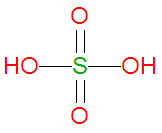Sulfuric acid: Difference between revisions
imported>David E. Volk No edit summary |
imported>Howard C. Berkowitz (Safety) |
||
| Line 29: | Line 29: | ||
: NaNO<sub>3</sub> + H<sub>2</sub>SO<sub>4</sub> → HNO<sub>3</sub> + NaHSO<sub>4</sub> | : NaNO<sub>3</sub> + H<sub>2</sub>SO<sub>4</sub> → HNO<sub>3</sub> + NaHSO<sub>4</sub> | ||
Contact of water and sulfuric acid is exothermic; when handling it, '''always add acid to water''', not the reverse or the resulting boiling can spray hot acid. | |||
The explosive [[nitroglycerin]] ([[glyceryl trinitrate]]), is made by reacting [[glycerine]] and nitric acid in the presence of sulfuric acid. '''This reaction is very dangerous, do not attempt.''' | The explosive [[nitroglycerin]] ([[glyceryl trinitrate]]), is made by reacting [[glycerine]] and nitric acid in the presence of sulfuric acid. '''This reaction is very dangerous, do not attempt.''' | ||
Revision as of 17:37, 9 July 2008
|
| |||||||
| sulfuric acid | |||||||
| |||||||
| Uses: | acid, dehydration, reduction | ||||||
| Properties: | strong acid | ||||||
| Hazards: | Toxic, Corrosive | ||||||
| |||||||
Sulfuric acid, also spelled sulphuric acid, is a strong, corrosive acid and reducing agent and is one of the most important chemicals in the chemical industry. Personal protective gear should be worn when using sulfuric acid.
Synonyms
Sulfuric acid is also called oil of vitriol, mattling acid, vitriol, battery acid, dipping acid, electrolyte acid, vitriol brown oil, sulphuric acid , Babcock acid and sulphuric acid.
properties and uses of sulfuric acid
Sulfuric acid is a strong acid, an oxidizing agent and a dehydrating agent. It is used to make many soluble phophates for fertilizers, ammonium sulfate and many other chemicals, including drugs. Newly made steel is cleaned with sulfuric acid to remove rust before the steel is coated with a protective layer of zinc, tin or enamel. It is also used in lead sulfate batteries. Many explosives are manufactured using sulfuric acid.
Because it has a high boiling point (330C), it can be used to make other more volatile acids using the appropriate acid salt. Nitric acid can be made by reacting sulfuric acid with sodium nitrate, NaNO3. Distilling the resultant nitric acid (BP=86C) drives the reaction towards completion.
- NaNO3 + H2SO4 → HNO3 + NaHSO4
Contact of water and sulfuric acid is exothermic; when handling it, always add acid to water, not the reverse or the resulting boiling can spray hot acid.
The explosive nitroglycerin (glyceryl trinitrate), is made by reacting glycerine and nitric acid in the presence of sulfuric acid. This reaction is very dangerous, do not attempt.
- C3H5(OH)3 + 3HNO3 + (H2SO4 catalyst)→ C3H5(NO3)3 + 3H2O.
Sulfuric acid can be used as a drying agent for gasses that do not react with sulfuric acid by bubbling the gas through sulfuric acid.
synthesis of sulfuric acid
Sulfuric acid is made be reacting sulfur trioxide with water in an exothermic reaction.
- SO3(g) + H2O(l) → H2SO4(l) + 130 kJ mole-1
In the commercial production of sulfuric acid, the contact process or the lead-chamber process is used. In the contact method, sulfur dioxide is catalytically converted to sulfur trioxide by surface chemistry with fine platinum powder or, more recently, vanadium pentoxide (V2O5). The resulting sulfur trioxide gas is bubbled through sulfuric acid and the addition of water at the correct rate yields 98% acid pulled out.
The lead-chamber process uses sulfur dioxide, oxygen, nitric acid and water vapor are introduced into a lead-lined chamber. White crystals of nitrosulfuric acid (nitronium sulfate), NOHSO4, are formed. The introduction of steam then converts the nitrosulfuric acid to sulfuric acid liberates nitrogen oxides, which can be reused in the first step of the reaction.
- 1) 2SO2 + NO + NO2 + O2 + H2O → 2NOHSO4
- 2) 2NOHSO4 + H2O → 2H2SO4 + NO + NO2
soluble and insoluble sulfate salts
The soluble salts of sulfate include sodium sulfate (Na2SO4)•10H2O, ammonium sulfate (NH4)2SO4, magnesium sulfate (Epsom salt, MgSO4•7H2O, copper sulfate (blue vitriol, CuSO4•5H2O), iron sulfate (FeSO4•7H2O), zinc sulfate (ZnSO4•7H2O), potassium aluminum sulfate (alum, KAl(SO4)2•12H2O), ammonium aluminum sulfate (ammonium alum, NH4AL(SO4)2•12H2O), and chrome alum (KCr(SO4)2•12H2O).
Barium sulfate (barite) is the least soluble sulfate salt and its white precitate is used as a test for sulfate anions. Other sulfates with diminished solubility include lead sulfate (PbSO4), strontium sulfate (SrSO4) and calcium sulfate (gypsum, CaSO4•2H2O.
